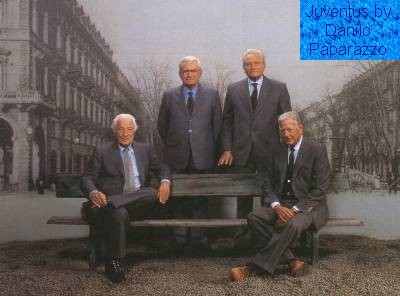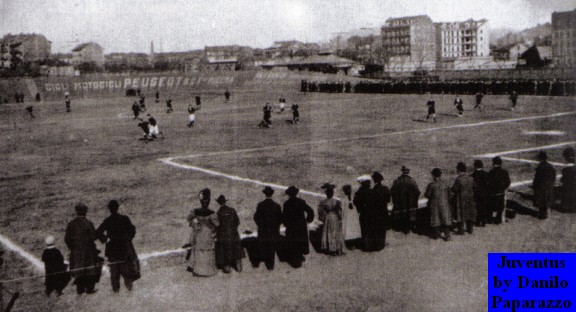
The Club, who's first president was Enrico Cafari, changed headquarters often but soon made a name for itself against many more expert teams in town. The players weared pink jerseys. Juventus made their debut in the Italian championship in 1900, wearing this uniform. The black and white one was imported directly from Nottingham in 1903. The team played in Piazza d'Armi. Meanwhile some of the early games were played on a field near the current train station of Porta Susa. This field was soon covered by buildings and Juventus rented a field on the Motovelodromo Umberto I in the Crocetta part of town instead. Juventus played here until 1906. Juventus then moved to the north of the city and the Stadio di Corso Marsiglia. This small stadium was known as “Campo Juventus" in Turin.
Juventus won their first Italian championship after a heart stopping three way final against Genoa and Milanese. This victory crowned the efforts of the Club's pioneers, under Swiss president Alfredo Dick, with the help of a number of foreign players. Alfredo Dick soon left the Club in anger, however, after losing support from the majority of players, and founded his own soccer team, called Turin. In doing so he took with him a number of valuable foreign players.
The ensuing years were not easy ones for the team, and up to the First World War Italian soccer was dominated by Pro Vercelli and Casale. Juventus stepped into the limelight again just after the war: goalkeeper Giacone and fullbacks Novo and Bruna were the first of the Club's players to be called on the National team. At this time the President was Corradino Corradini, a poet and man of letters.


In 1923 Giampiero Combi, one of the greatest goalkeepers of all times, made his debut on the team. On July 24 of that historical year the Club's Members unanimously elected Edoardo Agnelli, son of the founder of the Fiat automobile company, as President. The Club now boasted its own soccer field in Corso Marsiglia, with masonry stands to host the growing number of fans.
This was the prelude to five consecutive championship trophies in the 1930s, under coach Carlo Carcano and a lineup with champions such as Orsi, Caligaris, Monti, Cesarini, Varglien I and II, Bertolini, Ferrari and Borel II. This uninterrputed string of trophies went from 1930 to 1935, and at the same time players from the Club gave an important contribution to the Italian national team, which won the World Cup in Rome in 1934.
data scudetto ama prestasi dong Om, sama kl bisa Jersey_nya
The construction of the leggendary Stadio Comunale started in 1932. The stadium was built in only 7 months and was at first named after the fascist leader Benito Mussolini. The first game at the Stadio Mussolini was played on the 14th of May 1933. The stadium had a capacity of 71 160 spectators and was for many years the biggest stadium in Italy. After the war the stadium was renamed Stadio Comunale.

The Club's first steps in the international arena date to the same period, when it participated in the European Cup, illustrious ancestor of the Cup Winner's Cup, reaching the semifinals four times. In 1947 Gianni Agnelli, son of Edoardo who had died tragically in a plane crash in 1935, took the helm, bringing back the glorious years. At this time the Club's most representative champions were Carlo Parola, the Danes John Hansen and Praest, and above all Giampiero Boniperti, who was to become the Club's recordman for games played (444) and goals scored (177). Juventus won the National championship in 1950 and 1952.

In 1953 Giovanni Agnelli stepped down as president, a position which was to be filled two years later by his brother Umberto. A new cycle of victories was about to be inaugurated: the Club won the national championship in 1958, 1960, and 1961 with players such as Omar Sivori and John Charles, becoming the first soccer Club in Italy to have won ten national championships (in 1958) and being awarded the national medal for sports merits. Although city rivals Torino had their own stadium at via Filadelfia, its slow demise saw the club move to share the Comunale with Juventus in 1960.

Juventus returned to victory in 1967 under Vittore Catella's presidency, opening a long cycle of triumphs with its most representative champion, Giampiero Boniperti: the Club won nine national championships in fifteen years ( in 1972, '73, '75, '77, '78, '81, '82, '84, '86) plus all there was to win in the international arena: UEFA Cup (first success in 1977), Cup Winner's Cup (1984), European Cup, Supercup and World Club Championship (1985).
In these years the team was coached by Vycpalek, Parola and, above all, Giovanni Trapattoni. This was the time of great Italian champions (from Zoff to Scirea, from Tardelli to Cabrini, from Causio to Paolo Rossi, Gentile, Furino, Anastasi and the current vice president Roberto Bettega) but also of foreign champions such as Michel Platini, who played for Juventus five seasons, winning two national championship trophies, two European Cups, one World Club Championship, three times top scorer of the year and three golden balls.
In 1987 the capacity of the Stadio Comunale was reduced to 45 000 spectators due to security reasons, and it became clear that Turin needed a new stadium. The new Stadio Delle Alpi was built outside the city centre and was ready for the World Cup in 1990. The Turin population soon realized that the stadium had poor visibility and some spectators are 162 metres from the ball in certain moments of the game. Therefore the stadium never gained popularity, and Juventus will rebuild the stadium starting in the summer of 2005. The new Delle Alpi stadium will be ready in 2007.
The incredibly proliferous 1980's were inevitably followed by less glorious, but never dull moments: in 1990 Juventus won both the UEFA Cup and the Italian Cup (under president Vittorio Caissotti di Chiusano, who took over from Boniperti, and coach Dino Zoff) and again in 1993 the UEFA Cup.
After many dissapointing years, Marcello Lippi took over the helm at the club. He immediately won the Serie A title in 1995, nine years after the last "Scudetto" in 1986. Lippi crowned his fabulous first season at the club taking "The Double" by also winning the Italian Cup. A trophy the team has won more than any other, nine times since 1938.

Lippi continued his huge success at the club and also won back the Champions League to the club in 1996. Juventus had wanted to win the trophy since their last but tragic success at the Heysel stadium in 1985. The success continued, and in the 1996-97 season Lippi won the Serie A title, the European Supercup and the World Club Cup. Juventus lost the Champions league final against Borussia Dortmund in 1997 and against Real Madrid in 1998. The 1997-98 season was crowned by the 25th Serie A title of the club. Lippi was sacked in the 1998-99 season, but Juventus didn't manage to win under the helm of Carlo Ancelotti.
Marcello Lippi returned to the club in the summer of 2001 and immediately won back the Serie A title for the club. Juventus won their second consecutive Serie A title in the 2002-2003 season, but lost their third consecutive Champions League final. The year 2003 was tragic for the fact that both Giovanni Agnelli and Vittorio Chiusano passed away. In 2004 also Umberto Agnelli passed away. After a dissapointing 2003-2004 season Marcello Lippi left Juventus and took over the job as Coach for Italy from Giovanni Trapattoni. Juventus shocked everyone when they announced his replacement, Fabio Capello from Roma.
Juventus started to build their Mondo Juve complex in the summer of 2004. The gigantic training complex will consist of 9 training grounds and will be ready in the summer of 2005. The first team and all youth teams will train together in the complex located at Vinovo just outside Turin. Juventus will also start building their new stadium inside the current Delle Alpi stadium in May 2006. The new stadium will be ready in 2008.


